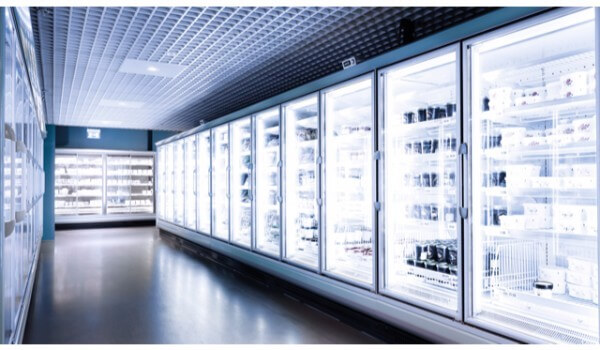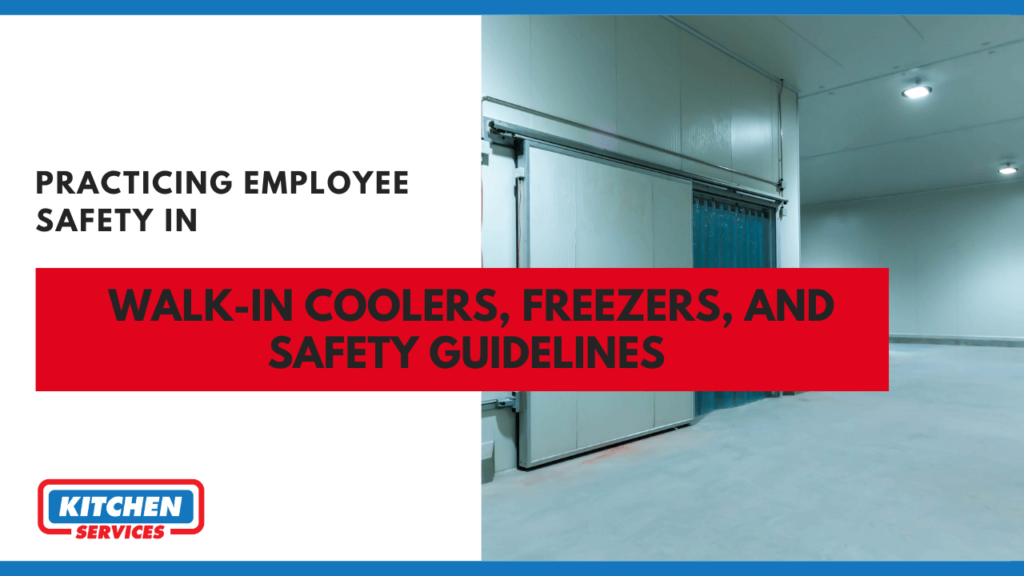You must know that a damaged refrigerator may lead you to inventory losses which will eventually slow down your business. In no time safety hazards turn into emergencies that cause permanent damage. There can be many sorts of haphazard like fire and electrical damage, slip-and-fall injuries, and environmental impact are also safety concerns that may occur other than just the performance of your coolers or freezer performance. Without considering the right safety measures, you may face a lot more damage than usual which you would not be able to cope with time.
If you are working in a related field then you must know that walk-in coolers are a crucial part of many businesses, but like any other machine, they can pose some safety hazards if we do not take the proper precautions in time.
Following are listed some of the ways to improve Employee Safety in Walk-in coolers at your business.
Employee Training
You should always provide proper walk-in freezer training to your employees. They must be given the proper tips and resources for their best possible safety.
- First and foremost, your employee must be 16 years of age or more to have the access to any walk-in unit. Any age less than 16 should not be accepted. Your company should prohibit workers younger than 16 from working in a walk-in cooler or freezer.
- All of the employees must be aware that one out of them will be in the walk-in unit for extended periods of time. so that nobody left him alone in that area in case of emergency.
- For their extra protection, ask your employees to execute the companion system.
- You must always check the walk-in unit when one shift ends to make sure no one is stuck inside the unit.
Provide Proper Safety Equipment
Working in walk-in freezer is not an easy job. You should provide proper safety equipment according to working-in-a-freezer laws to your employees.
- Always keep in mind that your walk-in cooler or freezer should have a handy safety release handle. These handles can prevent accidental traps.
- Always check this latch regularly to make sure it is in a good working condition.
- It is always a good idea to keep the fireman’s ax inside the walk-in unit in case of a emergency.
- You must always provide step stools for your workers to reach all those items that are hard for them to reach, and you better explain them in detail to not use boxes, milk crates, etc. as their stool.
- Try to use rubber anti-slip floor pads where possible.
7 Effective safety guidelines for operating a commercial refrigerator

Regardless of what kind of walk-in cooler, freezer you have in your facility or how often your employees access your cooler, it’s important to follow some essential guidelines for Employee Safety in Walk-in coolers. Following these tips, you and your employees can safely work in and around your walk-in refrigerator or freezer with your mind at ease.
Keep spaces clean, dry and organized
If you keep your walk-in coolers dry and organized, you may end up avoiding so many emergency conditions. Follow these steps for keeping your walk-in coolers and freezers dry and clean.
- Immediately clean up any spills soon after they happen.
- Buy a lot of squeegees and use them to mop the excess water on the floor drain so it can dry faster.
- Try to keep sidewalks clear and free of slipping risks.
- As we know that even in the normal home refrigerators ice buildup can cause puddles, so scrape it and defrost frequently.
- If you regularly clean it will also reduce the risk of possible fungus and mold. These not only lead to your employees feeling sick but can ruin your stock as well.
- Try to never overload shelves and always pay attention to the weight limits of your shelving.
- Always keep heavy items at the waist height or even lower.
Keep Fans Unhindered
The working of any sort of coolers and freezers crucially depends on its fans, as these fans maintain the ideal temperature for your freezer. But if these fans are hindered they won’t be able to push out hot air to keep the inside of the refrigerators cold enough. With the passing time, these fans will start pushing a commercial refrigerator to work harder in order to maintain ideal food at safe temperatures, this may also bring the machine to the point of breakdown causing higher utility bills.
But the actual danger that comes with the overworking of the fridge is overheating. This electrical danger can cost your entire business when this risk is absolute. To be on the safer side and to avoid extensive damage, you should always keep an eye on the fans and anything that possibly be blocking them. You should also avoid pulling out the unit from the wall to prevent the fans and vents from overheating, especially in these tight spaces.
Regularly check safety releases on doors
There are many advanced walk-in coolers & freezers available in the market that comes with safety releases on doors through which you can avoid the risk of the accidental trap. If any of your employees are locked inside a walk-in cooler or freezer there are higher risks of hypothermia or even death because of the temperatures which can be below freezing. Always make sure to regularly check these safety releases to make sure they are functioning properly.
Keep your Walk-In Unit clean
As discussed earlier in this article, you must regularly clean your walk-in refrigeration systems because it can lower the risk of mold or fungus buildup. As exposure to mold can make your employee sick as they can get many infections that cause coughing, sneezing, and other sinus troubles as well. Mold will not only harm employees but also can ruin your inventory. So, regular cleaning of your walk-in coolers and freezers will help minimize the risk of mold exposure.
Wear protective gear
This is the most important factor to consider while you are sending someone in your walk-in coolers and freezers for any sort of work. Standing for a long in the frozen aisles you will definitely feel the chill. But in our daily routines where there are customers who are coming and going, your staff must be loading docks and storage areas and they are frequently exposed to sub-zero temperatures inside those commercial refrigeration units. Being their caretaker as there is your responsibility you need to make sure to provide your staff with proper safety gear that includes gloves and suits to protect them from the chilled temperatures.
You must note that protective gear also helps to reduce the risk of possible injuries. Many of the food items usually come in heavy protective packaging which can be very hard to handle and rough on the body. Reduce the risk of injuries from product handling with the right gear.
Try Not to overload shelves
You should know that an overpacked freezer becomes less efficient and overloaded shelves can fall down under the surplus weight. Your employees may have those overloaded items fall on top of their heads if shelves break or malfunction in any case. Almost all of the shelves have a maximum weight that should never be exceeded.
You can always protect your inventory and your employees by keeping your walk-in not filled beyond its limited capacity.
Walk in Freezer Safety Requirements
- Temperature Control: Maintain between -10°F to -20°F; regular thermostat checks.
- Lighting: Ensure sufficient, shatterproof interior lighting and emergency backup.
- Escape Features: Install inside release latches and panic alarms to prevent entrapment.
- Slip-Resistant Flooring: Use non-slip flooring and ensure proper drainage.
- PPE: Workers must wear insulated gear and non-slip footwear.
- Ventilation: Ensure proper airflow and ventilation to prevent gas buildup.
OSHA Walk-In Freezer Regulations
OSHA (Occupational Safety and Health Administration) sets various safety guidelines for working in walk-in freezers to ensure workers’ safety from cold-related injuries and other hazards. Here are some key regulations:
- Temperature Monitoring: OSHA recommends maintaining temperatures that avoid extreme cold exposure, ideally between -10°F (-23°C) and 32°F (0°C), depending on the nature of the product stored and time exposure.
- PPE (Personal Protective Equipment): Workers must be provided with adequate PPE such as thermal gloves, jackets, and boots to protect against cold stress.
- Emergency Exits and Safety Latches: Walk-in freezers must have emergency release mechanisms or safety latches to prevent employees from becoming trapped inside.
- Lighting: Proper lighting must be maintained inside the freezer to prevent accidents.
- Ventilation: Adequate ventilation must be ensured to prevent hazardous buildup of gases like carbon dioxide (CO2) or ammonia in refrigerated spaces.
- Rest Breaks: OSHA suggests regular rest breaks in warm environments to avoid cold stress and other related health problems, such as frostbite and hypothermia.
Also Read: Refrigerator Temperature Guidelines
Book A Regular Maintenance Service

Last but never least, do not forget the regular maintenance of your freezers. You must know that regular assessments will easily reveal underlying functioning issues of your machine even before an unfortunate breakdown and allow a certified refrigerator mechanic to repair them at the right time. this can prevent you from having future mishaps.
You must always check with the faulty wiring and try to restore key components such as compressor, condenser, evaporator coils, and drain lines for ideal performance. This will let your commercial refrigerator work efficiently and maintain food-safe temperatures all day long while keeping energy costs low.
Employee Safety in Walk-in coolers FAQs
What to wear when working in a freezer?
When working in a freezer, it’s crucial to wear the right clothing to protect against cold exposure. Key items include:
- Thermal Insulated Jacket: A heavy-duty, insulated jacket or parka to protect against cold temperatures.
- Thermal Pants: Insulated pants or coveralls to keep the lower body warm.
- Gloves: Insulated, water-resistant gloves to protect hands from frostbite.
- Insulated Boots: Warm, insulated, and slip-resistant boots to protect feet from the cold and slippery surfaces.
- Hat or Hood: A thermal hat or hood to protect the head, ears, and neck from cold exposure.
- Layered Clothing: Layering with moisture-wicking base layers under insulated outerwear helps regulate body heat while working in fluctuating conditions.

